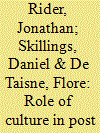| Srl | Item |
| 1 |
ID:
083599


|
|
|
|
|
| Publication |
2008.
|
| Summary/Abstract |
The article focuses on the study of the Ism'?l? saints (awliy) andshrines (qadamgh) in the Wakhan region of Tajikistan along with their historical context. Its essential purpose is to draw a succinct historical and ethnographic picture of shrine culture in the region and determine its religious significance in the broad frame of socio-cultural context of Wakhan. While discussing rituals associated with saint veneration and shrine visitation, it elaborates on the changing role of shrine culture in modern Wakhan and its adaptation to the newly established social and cultural circumstances after the collapse of the Soviet Union. It is argued that the process of religious and cultural revival in post-Soviet Wakhan had its own distinctive element manifested in the transformation of the existing shrines into museums or 'museumization' of shrines, a process that not only changed the spatial compositions of the shrines but also enhanced their social and cultural functions.
|
|
|
|
|
|
|
|
|
|
|
|
|
|
|
|
| 2 |
ID:
175074


|
|
|
|
|
| Summary/Abstract |
This article presents a discussion about the role of cultural heritage in post-emergency reconstruction. The three authors, presenting viewpoints from their own experience in the field, argue that cultural heritage has significant potential to foster economic development, especially among communities living in remote geographic areas. Cultural heritage provides comparatively unique opportunities (especially in countries like Afghanistan) for engaging with marginalised groups such as women, youths and those from low-income communities. The article discusses the potential for cultural heritage in these situations to empower local communities, but also discusses the role that international organisations and private enterprise can play with regard to cultural heritage in post-conflict and post-disaster recovery.
|
|
|
|
|
|
|
|
|
|
|
|
|
|
|
|
| 3 |
ID:
175330


|
|
|
|
|
| Summary/Abstract |
Wakhan, northeast Afghanistan’s peripheral panhandle, is situated between Afghanistan’s borders with Tajikistan, China and Pakistan. Once subject of Great Game rivalry, it requires multiagency fieldwork to better understand its geopolitical vulnerabilities. Existing accounts of Wakhan are deemed inadequate and inappropriate, exceptionalising its wildness and wilderness, and drawing (in)civility distinctions that legitimise a near-divine right to dominion. Reassessing Wakhan in a boundary biography, the paper argues that by conceiving boundaries as local manifestations of international dynamics, marginal boundary regions can serve as tests for the ‘state’ of international affairs. The paper firstly assesses evolving understandings of boundaries before conceiving them as local manifestations of international dynamics. Existing narratives are then observed to render the region subaltern.
|
|
|
|
|
|
|
|
|
|
|
|
|
|
|
|